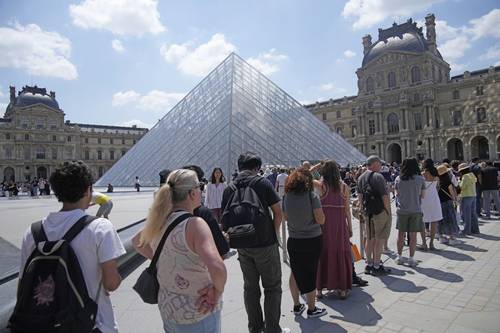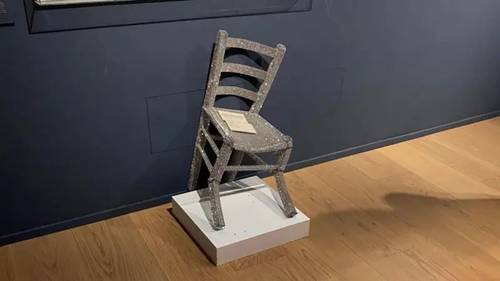“In Mexico, we need to understand the history of pottery in order to appreciate it.”

In Mexico, we need to know the history of pottery in order to value it.
Marcela Calderón, from Patamban, Michoacán, teaches classes at La Esmeralda // Here they prefer to teach techniques from Japan and Spain
, the ceramist laments
▲ Some of the pieces crafted by artisan Marcela Calderón Bony. Photo by Cristhian A. Espinosa
La Jornada Newspaper, Tuesday, June 17, 2025, p. 4
Pottery in Mexico is a folk art steeped in tradition; however, for communities, competing with large industries is impossible: sometimes the market demands rapid production, and mass-produced pottery is very complicated. In several regions of the country, production rates are seasonal
, explained Marcela Calderón Bony, a ceramist from Patamban, Michoacán.
The contemporary potter, who learned her technique in a traditional clay workshop, recounted that her first exposure to the craft came from observation, and that despite the social adversities that exist on the Purépecha plateau, artisans in that region continue to carry out their work in an unfavorable economic climate.
In an interview with La Jornada, Marcela Calderón Bony, who teaches ceramics at the La Esmeralda National School of Painting, Sculpture and Engraving, commented that “Mexico is infinitely rich in pottery, but its history needs to be better known in order to value the craft, so that people come to learn why it is important to learn about its culture.
It's essential that this folk art be more appreciated in the country, as many communities have preserved and passed on this knowledge for years. It's a craft that's inherited, like mine, who learned by imitation, from how to pick up the stone and how to make the clay tortilla to how to knead it
, he emphasized.
Mexico's potters not only showcase the folk art of a region: they also convey emotions and history through objects born from the earth and water, highlighting their talent and sensitivity in clay, which has given rise to hundreds of cultures distinguished by a variety of techniques.
In addition to being a teacher, Calderón Bony produces her ceramic pieces at Taller36, founded in 2013 in Mexico City, using traditional techniques she learned at her parents' high-temperature cooperative, Ricardo Calderón and Catalina Bony, in Michoacán. They continue to create pitchers, salad bowls, cups, and casseroles, among other pieces.
"Technological innovations are replacing the pottery used by families in these regions. In the village, clay has been replaced by aluminum, pewter, and plastic, and previously, they were used to make the objects that the entire village used for eating, so their work was very important.
In Mexico City's ceramics schools, they teach them how to make pottery like in Japan or Spain; they don't teach them how to move their hands like the country's potters do. Instead, I teach my students how it's made in Mexico, how it's made in Patamban
, Calderón Bony concluded.
Cristhian A. Espinosa
The Louvre closes, overwhelmed and understaffed, a warning of overtourism.
Museum staff went on a spontaneous strike yesterday // Thousands of tourists were left outside without information

▲ Tourists waited in long lines for information about the unusual interruption of activities at the venue. AP Photo
Ap
La Jornada Newspaper, Tuesday, June 17, 2025, p. 5
Paris. The Louvre, the world's most visited museum and a global symbol of art, beauty, and resilience, remained closed yesterday, not because of war or terror, but because of its own exhausted staff, who maintain that the institution is crumbling from within.
It was an almost unthinkable prospect: the home of works by Leonardo da Vinci and the greatest treasures of civilization, paralyzed by the very people charged with welcoming the world into its galleries. Yet the moment felt bigger than a labor protest. The Louvre has become a bellwether of global overtourism, a gilded palace overwhelmed by its popularity. As tourist magnets from Venice to the Acropolis rush to limit crowds, the world's most iconic museum faces its own reckoning.
The spontaneous strike broke out during a routine internal meeting, when gallery assistants, ticket agents and security staff refused to take up their posts in protest at unmanageable crowds, chronic understaffing and what one union called unsustainable
working conditions.
“It’s the Mona Lisa wailing out here,” said Kevin Ward, 62, of Milwaukee, one of thousands of confused visitors corralled in motionless lines beneath I.M. Pei’s glass pyramid. Thousands of people waiting, no communication, no explanation. I guess even she needs a day off
.
It's rare for the Louvre to close its doors to the public. It's happened during wartime, during the pandemic, and during a brief staff strike in 2019, but never like this: with tourists lined up in the square, tickets in hand, and with no clear reason as to why the world's most famous museum simply came to a standstill.
The disruption comes months after President Emmanuel Macron unveiled an ambitious, decade-long plan to rescue the Louvre from precisely the problems now erupting: water leaks, dangerous temperature swings, aging infrastructure, and foot traffic far beyond what the venue can handle. But for workers on the ground, that promised future feels distant.
We can't wait six years for help
, said Sarah Sefian of the CGT-Culture union. Our teams are under pressure now. It's not just about the art; it's about the people who protect it.
At the center of it all, as always, is the Mona Lisa, a 16th-century portrait that draws modern crowds more like a celebrity encounter than an art experience.
Approximately 20,000 visitors a day crowd into the Salle des États, the museum's largest hall, just to take a selfie with Leonardo da Vinci's enigmatic woman behind protective glass. The scene is often noisy, hectic, and so dense that many barely glance at the flanking masterpieces, paintings by Titian and Veronese, which largely go unnoticed.
“You don’t see a painting
,” lamented Ji-Hyun Park, 28, who flew from Seoul to Paris. “You see phones. You see elbows. You feel heat. And then, you’re pushed out
.”
Macron's renovation plan, dubbed the Louvre's New Renaissance
, promises a solution. The Mona Lisa will finally have its own room, accessible via a timed-access ticket. A new entrance near the Seine River is also planned for 2031, to relieve pressure on the pyramid's overcrowded center.
“The conditions of exhibition, explanation, and presentation will be on par with what the Mona Lisa deserves,” Macron said in January.
The Louvre welcomed 8.7 million visitors last year, more than double the number its infrastructure is designed to accommodate. Even with a daily limit of 30,000, staff say the experience has become a daily test of endurance, with very few rest areas, limited restrooms, and the summer heat magnified by the pyramid's greenhouse effect.
In a leaked memo, Louvre president Laurence des Cars warned that parts of the building are no longer waterproof
, that temperature fluctuations endanger priceless art, and that even basic visitor needs, such as food, restrooms, and signage, fall far short of international standards. She described the experience simply as a physical ordeal
.
The entire renovation plan, projected to cost just over $800 million, is expected to be funded through ticket revenue, private donations, state funds, and licensing fees from the Louvre's Abu Dhabi branch. Ticket prices for non-European Union tourists are expected to increase later this year.
But workers say their needs are more urgent than any 10-year plan.
Unlike other major Parisian sites, such as Notre Dame Cathedral and the Centre Pompidou, both undergoing government-backed restorations, the Louvre remains stuck in limbo, neither fully funded nor fully operational.
President Macron, who delivered his 2017 election victory speech at the Louvre and displayed it during the 2024 Paris Olympics, promised a safer, more modern museum by the end of the decade.
Until then, France's greatest cultural treasure and the multitudes who flock to it remain trapped between the cracks.
Verona Museum sues man who broke glass-covered chair

▲ The chair is covered with Swarovski crystals and is a work by Nicola Bolla. Photo taken from Palazzo Maffei's social media.
AFP
La Jornada Newspaper, Tuesday, June 17, 2025, p. 5
Rome. The Palazzo Maffei museum in Verona, Italy, announced yesterday that it had filed a complaint against a tourist who sat on a chair made of Swarovski crystals and broke it.
On Thursday, the museum published a video from its security cameras showing a tourist sitting on this work of art while a woman takes photos. As he sits down, the chair collapses. "A museum nightmare
," the museum wrote on Instagram.
This is a work by Nicola Bolla, acquired by the venue in 2022, inspired by the straw chair in one of Vincent van Gogh's paintings.
The visitors fled before museum staff stopped them and could not be identified.
The Palazzo Maffei, which declined to give a value for the work, filed a complaint, stating that the incident occurred less than four weeks ago and that the chair has since been restored and is back on display.
It's a stupid gesture (...), but I also see a positive and artistic side to it
, the author of the work declared in the Italian media Fanpage.
The Palazzo Maffei Museum in Verona exhibits both ancient and contemporary works.
jornada





